One way to look at the second Robin, Jason Todd, is that he started out as a well-executed bad idea and ended up as a poorly executed great idea. Another way to look at the character is that DC at first tried to recreate the Golden Age but then it realized it was the 1980s, so it threw any vestiges of innocence out the window in a coke & ecstasy-fueled fit during a synth-scored rave party.
To be sure, the notion of replacing Dick Grayson as the Boy Wonder was not bad in itself, certainly not in 1983, when Dick had clearly outgrown the part. But rather than coming up with a new concept of Robin, their idea was to just blandly remake the original – so we were given another son of circus trapeze artists (‘The Flying Todds’) orphaned by crime while Bruce Wayne was around. It was a pretty lame way to finish Gerry Conway’s underrated run on the Bat-books… Fortunately, Conway was followed by Doug Moench, whose stellar writing also deserves great praise and close observation (I’m working on it, guys!).
Jason Todd struggled to earn his place, as Moench took his time to complete the switch, showing Batman’s hesitations and Jason’s insistence for months. This made Batman seem less like an asshole who endangered kids willy-nilly while also building up Jason’s personality. Neatly, even when the Dark Knight agreed to commit to their partnership, it wasn’t immediately taken for granted that Jason would wear the same suit as Dick Grayson and call himself Robin:
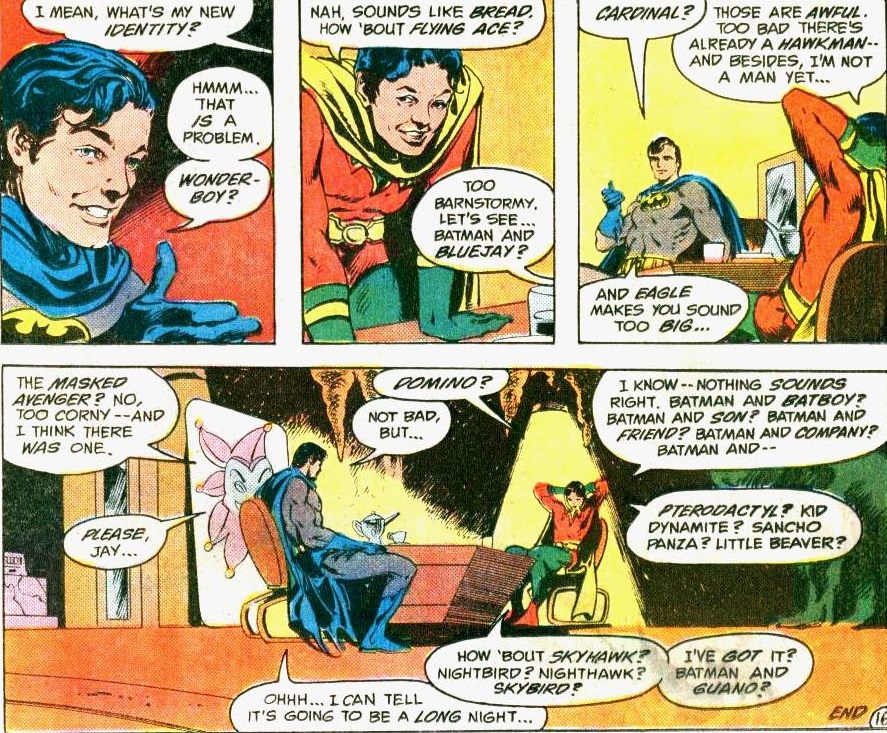 Detective Comics #534
Detective Comics #534
Dick eventually showed up to pass the torch. Having moved on to his Nightwing persona, he gave Jason his blessing to become the new Boy Wonder. This was a big step – by then the title of Teen Wonder had been so firmly established that the issue cover felt the need to make a big fuss about the change:
Doug Moench nailed the potential of the new status quo, as Batman once again got to hang out with a bright, enthusiastic young sidekick. That said, Bruce was often more of a father figure than a crime-fighting partner. Already at the time, much of the characterization in these comics involved Batman continuously holding back, telling Robin to stay away from cases that looked particularly dangerous, and Jason impetuously disobeying him. Unlike what happened in later stories, however, this version of Jason was clearly a nice kid, whose flaw was over-eagerness, not vindictive sadism.
Not only was pre-Crisis Jason Todd damn likable, he also became more and more integrated in the wider DC Universe. For example, in an unintentional foreshadowing of their later relationship in Red Hood and the Outlaws, the lucky rascal got to meet Starfire:
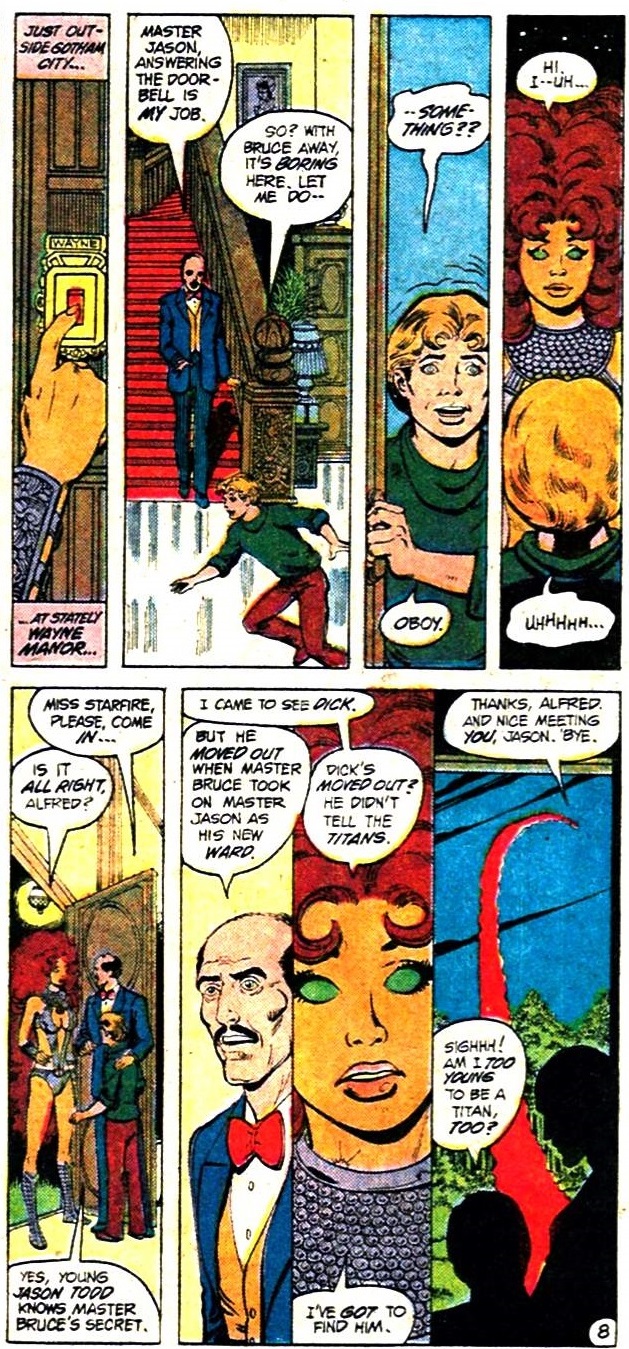 The New Teen Titans #33
The New Teen Titans #33
Impressively, in the classic ‘For The Man Who Has Everything,’ the new Boy Wonder even saved the asses of Batman, Wonder Woman, and Superman!
Then again, he got seriously beaten up by an angry mob in the crossover Legends, where public opinion turned against superheroes across the DC Universe:
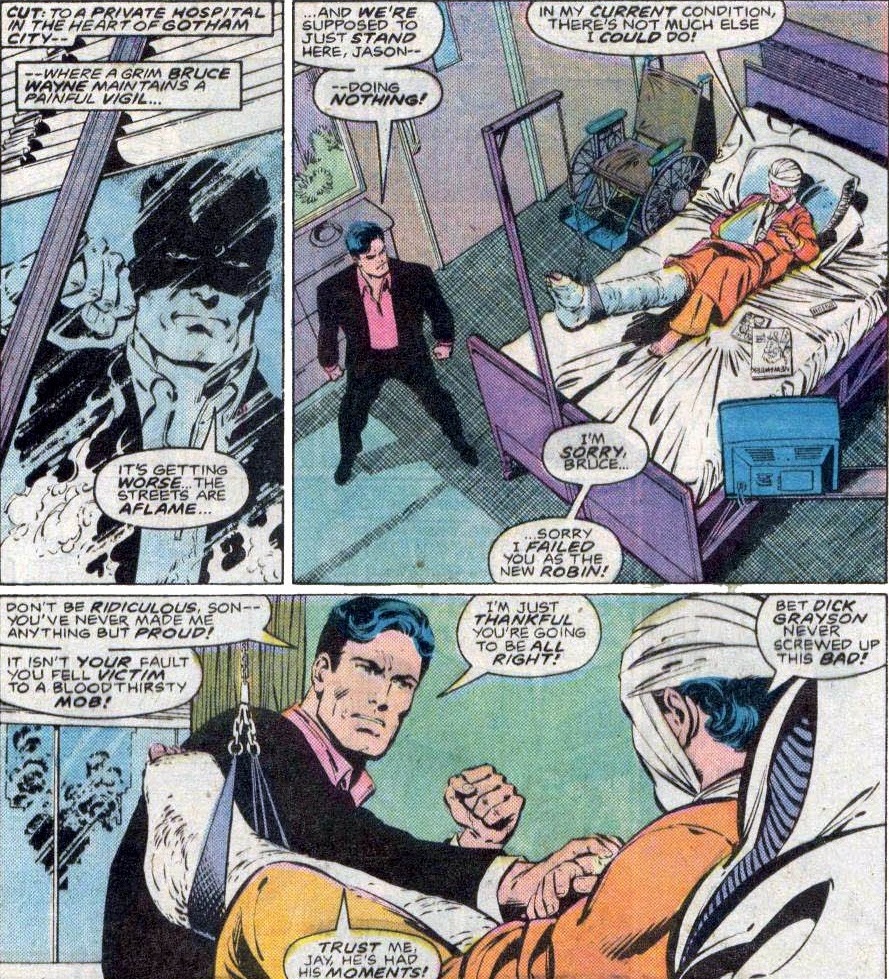 Legends #3
Legends #3
The most important crossover of the era was, of course, Crisis on Infinite Earths, which led to a soft reboot of Batman continuity. DC took the opportunity to give Jason Todd a more interesting background: he was now a street kid whose father had died while working as a flunky for Two-Face. In the revamped origin, Batman actually caught Jason in Crime Alley trying to steal the tires of the Batmobile!
I think this was a keen idea. It made Jason Todd a very different character from Dick Grayson by giving him street smarts, a problematic childhood, and ultimately his own reason to appreciate Bruce as a surrogate-father and crime-fighting mentor. Instead of the clean-cut, wholesome Boy Wonder of yesteryear, Robin was now closer to the irreverent image of modern youth. At the same time, this also gave Batman a different kind of relationship with his sidekick, since he had to tame Jason’s rebellious instincts.
I’m not a huge fan of the comics that introduced these changes (written by the otherwise dependable Max Allan Collins). Luckily, later they were awesomely retold from Dick Grayson’s perspective in Nightwing: Year One, where Dick and Jason got to bond while looking for a missing Alfred:
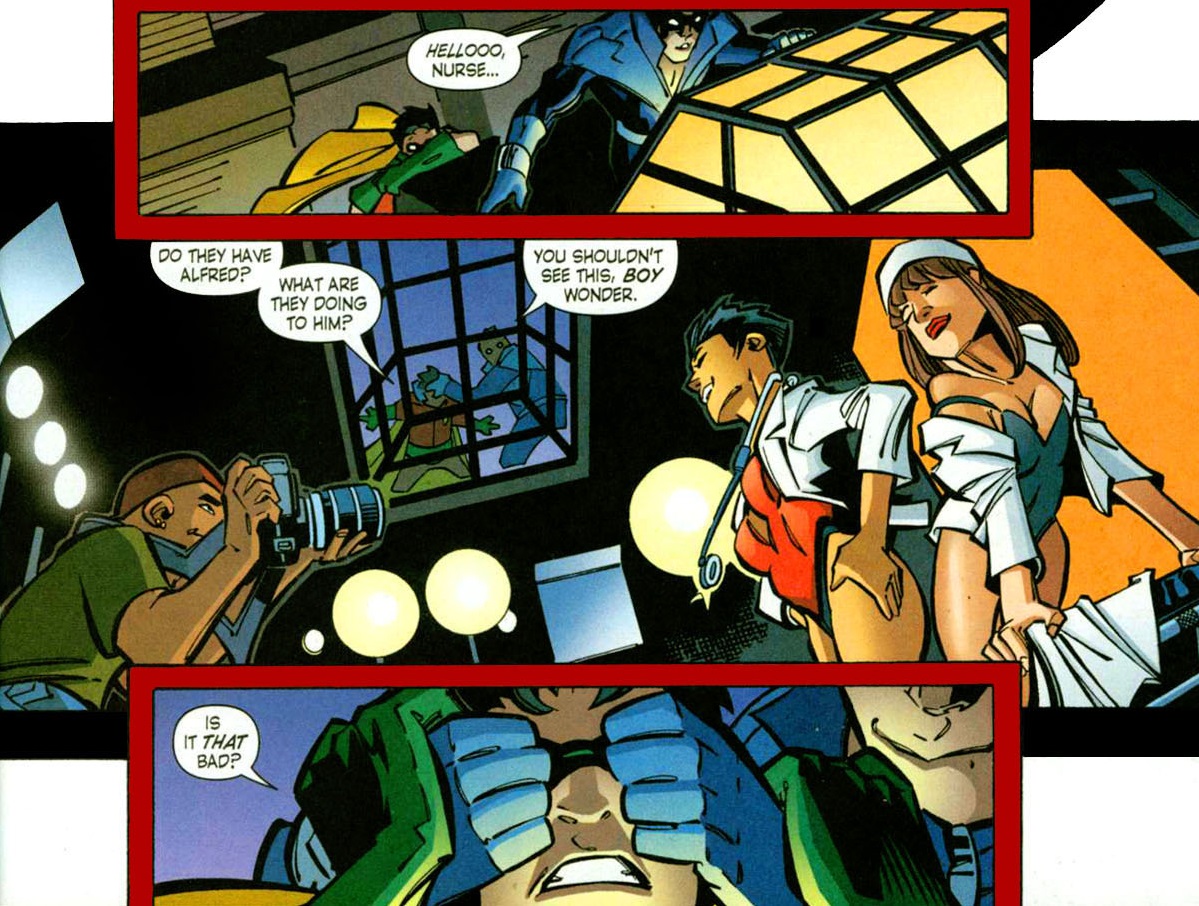 Nightwing #106
Nightwing #106
It’s worth pointing out that, even after Crisis on Infinite Earths, many of the earlier stories featuring Jason Todd as Robin had quite a Batman ’66 vibe:
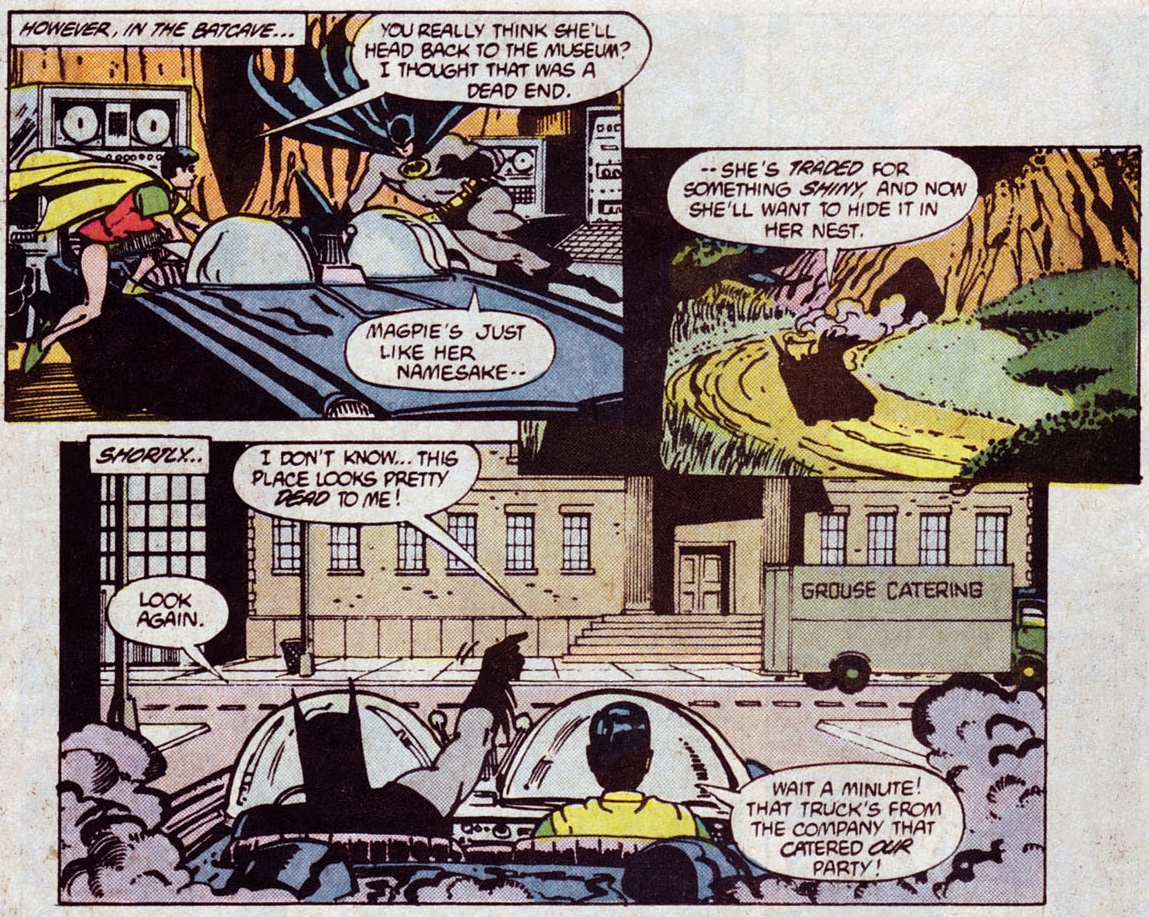 Batman #401
Batman #401
This was most notable in Mike W. Barr’s fan-favorite run in Detective Comics, which featured one of the neatest depictions of Jason Todd. Barr wrote Robin as an impulsive wiseass, but was careful not to turn him into a douchebag. Instead, Jason came across as peppy and plucky and, you know, as someone who generally seemed to be having a blast hanging out with Caped Crusader!
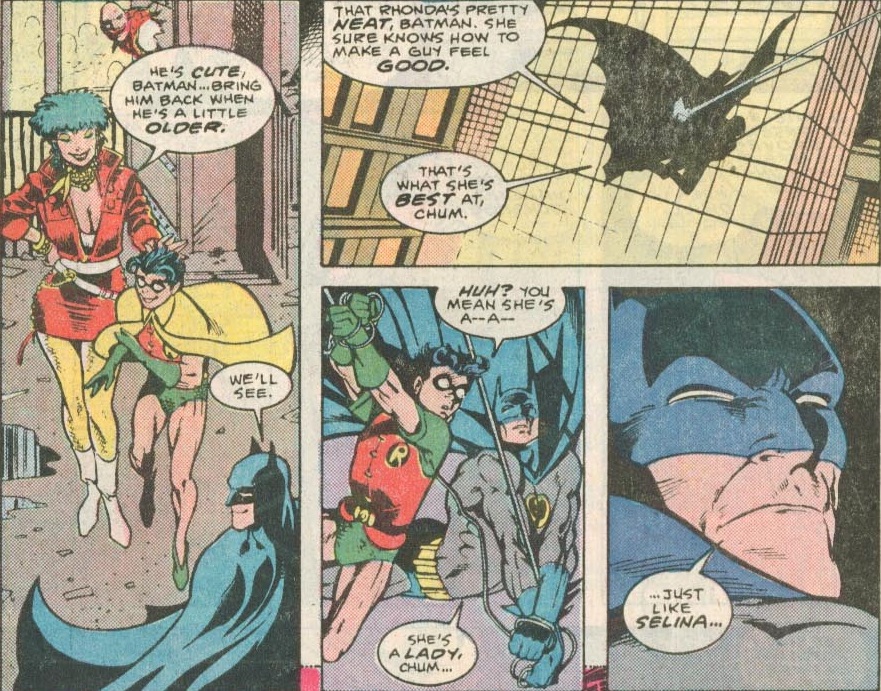 Detective Comics #570
Detective Comics #570
Things changed dramatically once Jim Starlin started to write Batman, in late 1987. Grimly steeped in sexual violence and terrorism, Starlin’s run was as eighties as it gets. The Dark Knight even fought a Soviet agent named KGBeast, in what was possibly the most preposterous Cold War fanfic since Rocky IV!
Starlin gave Jason Todd a makeover, turning him from a charmingly reckless kid into an edgy, angry teenager who apparently killed a criminal at one point (in ‘The Diplomat’s Son’). If Jason’s arc had first been treated as a straightforward success story, his growing pains now became a serious challenge for Batman. Here he is beating up a pimp:
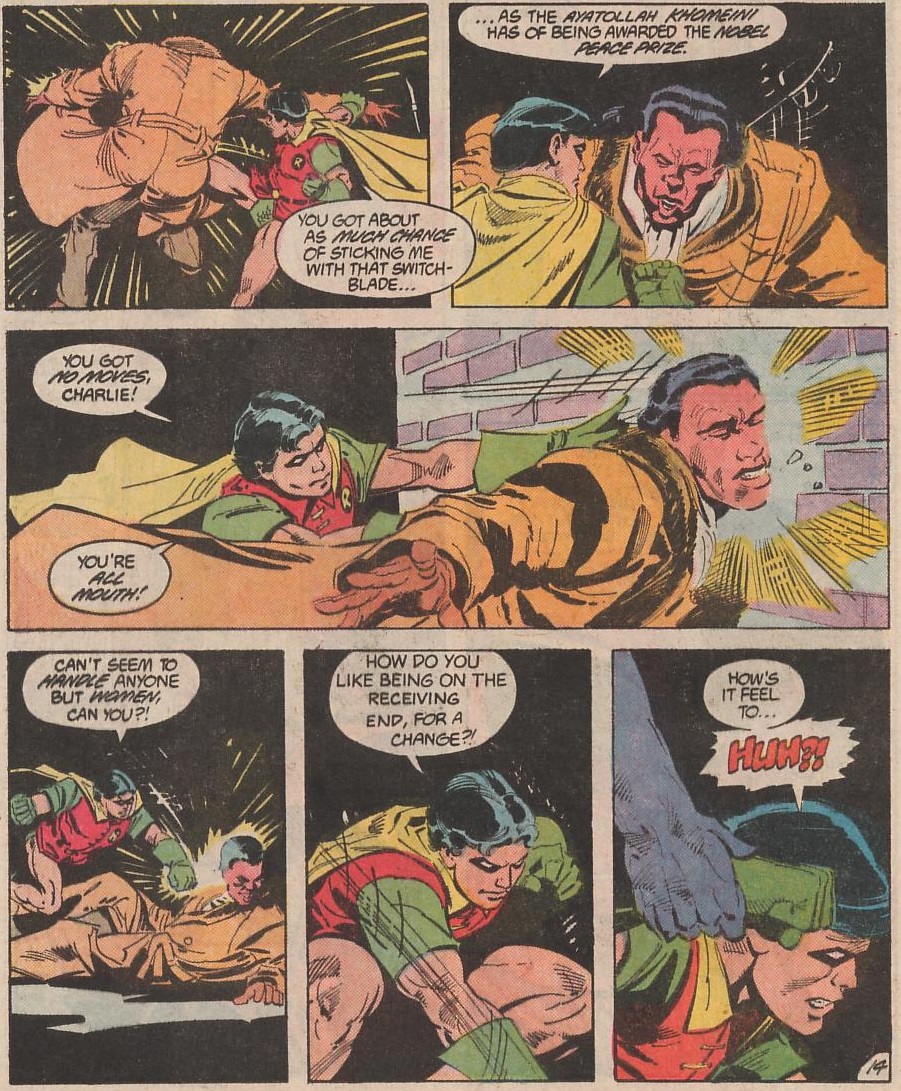
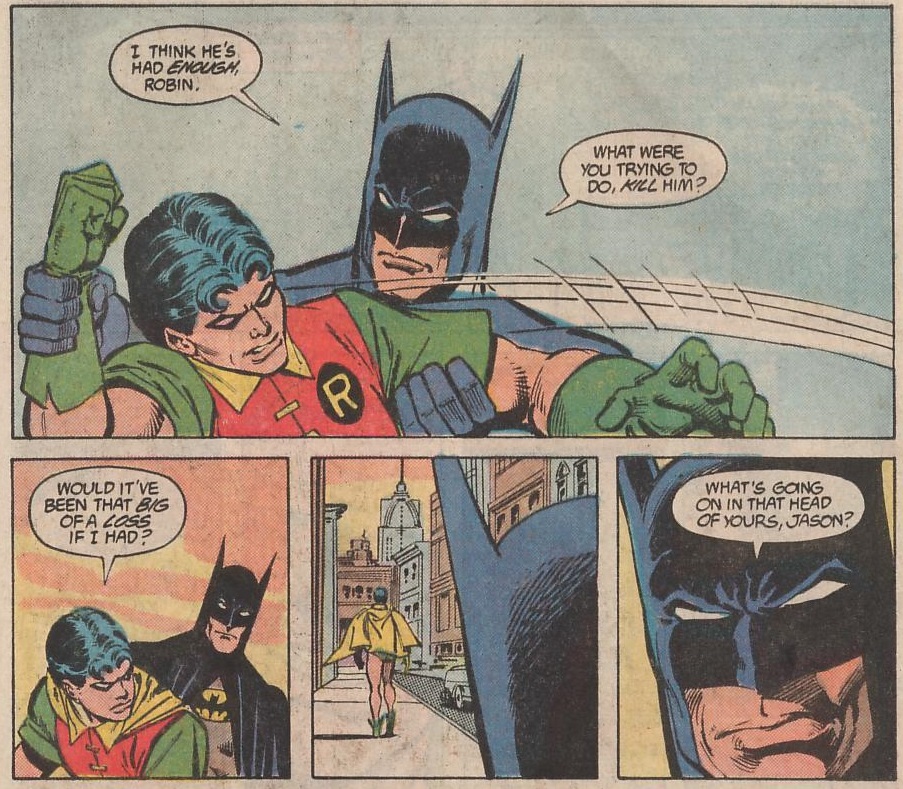 Batman #422
Batman #422
Talk about attitude.
To be fair, it was the eighties. While the recent wave of nostalgia for ‘80s pop culture has given us some cool movies (the latest being Turbo Kid), the fact is that, between the politics, crime, and socioeconomic wreckage, this was a pretty fucked up time to be a teen (as captured in the kickass Deadly Class comic series).
Still, as much as Robin got caught up in the zeitgeist, Jim Starlin seemed to be deliberately making Jason more and more unlikable in order to prep him to die. As soon as he came aboard, Starlin started lobbying to kill off the brat – and although DC didn’t let him give Robin AIDS, editor Denny O’Neil gradually found himself considering the dramatic potential of offing the Boy Wonder.
It must have helped that the shadow of The Dark Knight Returns loomed large over the Batman comics of the time. This tale, which was still being teased as a possible future for the world of the Caped Crusader, implied that Jason Todd was to meet a terrible fate. Whether planned or coincidentally, two of Mike Barr’s stories (‘Fear for Sale’ and ‘…My Beginning… And my Probable End.’) had already foreshadowed the significance of Jason’s death for Batman.
And then came ‘A Death in the Family.’ This is the book where Jason Todd ran away from Wayne Manor to go looking for his birth-mother and ended up in Beirut. In an amazing coincidence, Jason bumped into Batman, who had also come to Lebanon yet for completely unrelated reasons. The Dark Knight had followed the Joker to the Middle East, where the Clown Prince of Crime was trying to sell a nuclear rocket to Arab terrorists who wanted to bomb Tel Aviv.
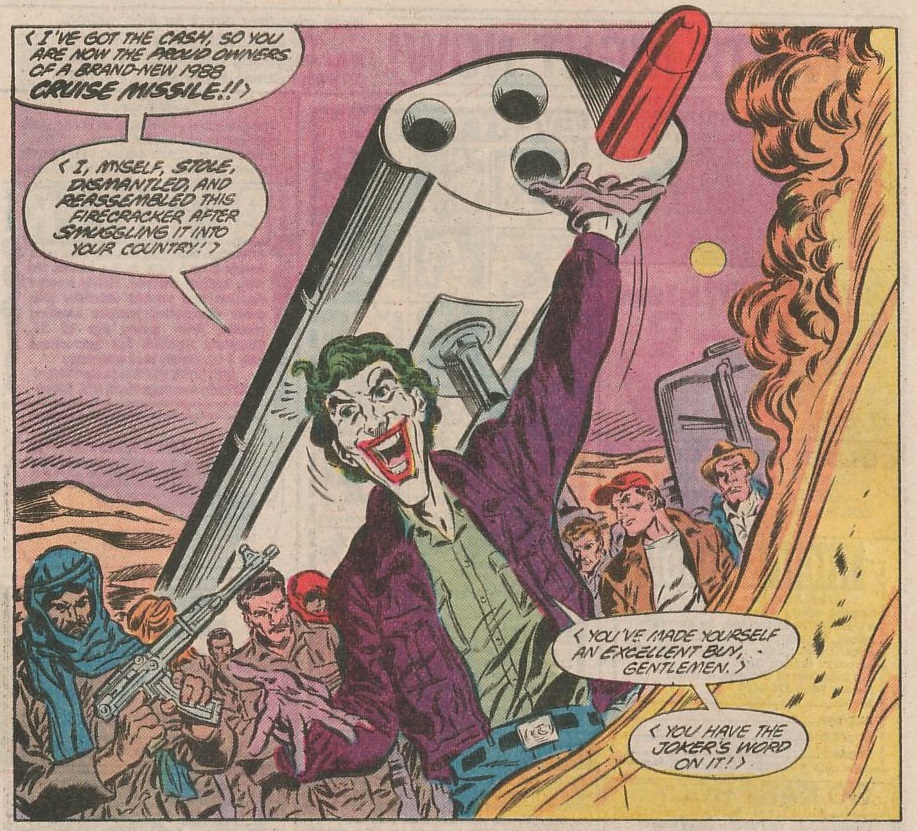 Batman #426
Batman #426
The Joker escaped to Ethiopia and, in another not-at-all-convoluted plot twist, Jason’s search for his mother took him there as well… in fact, it took him to the exact same spot, at the exact same time! So the Joker, that wacky fella, beat the shit out of Robin with a crowbar and left him to die in an explosion.
DC then infamously set up a pair of 1-900 phone numbers where people could vote as to whether the young hero survived the explosion or not. He didn’t.
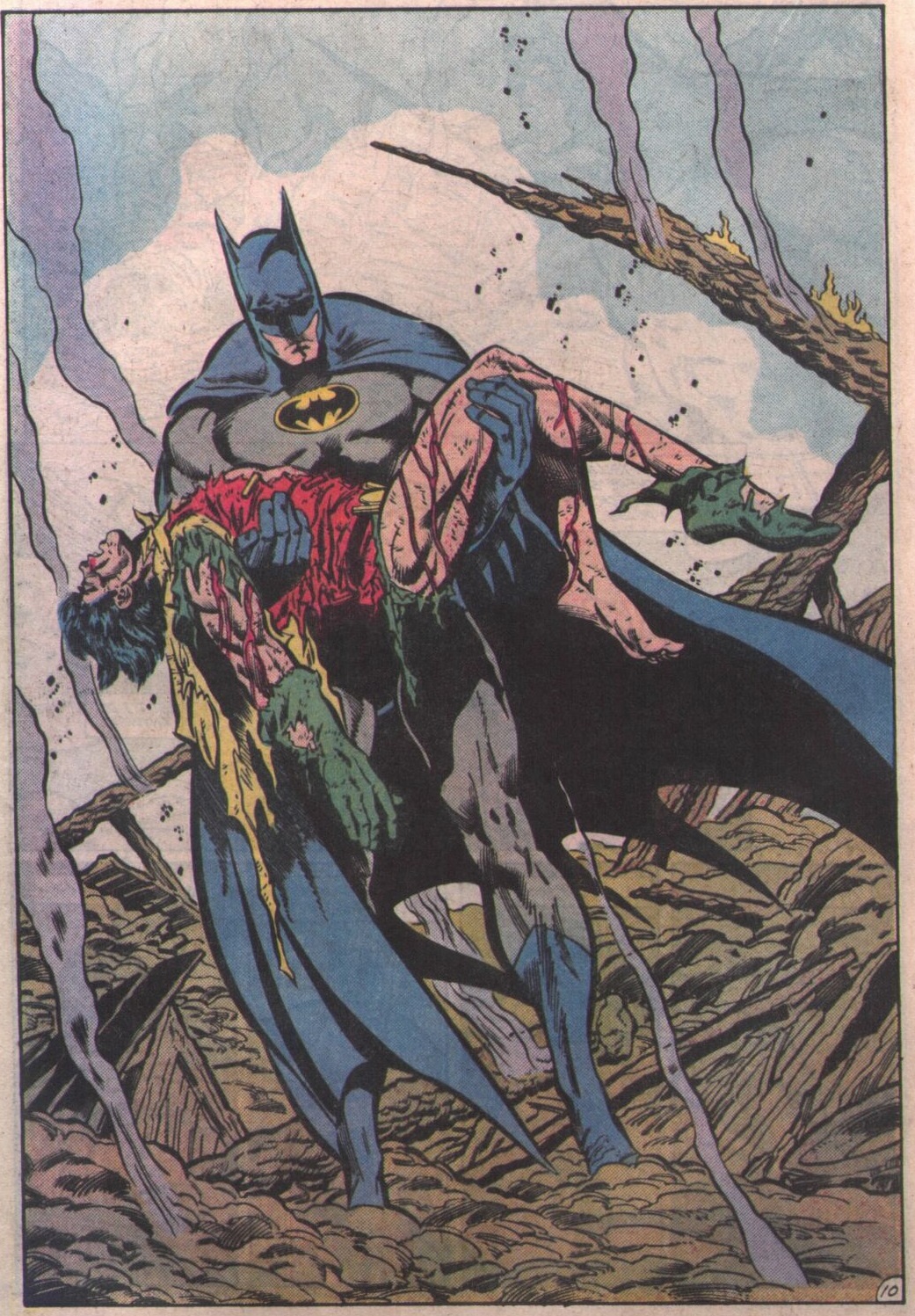 Batman #428
Batman #428
There is still some speculation over whether or not DC planed on killing (or at least retiring) Jason Todd regardless of the result of the poll. After all, the story title was ‘A Death in the Family’ for crying out load! I trust Brian Cronin on this (and on pretty much everything).
The truth is that, even if you don’t agree with the final decision, several good things came out of DC’s sadistic stunt (besides the evidence-based confirmation that comic fans are seriously twisted). First of all, ‘A Death in the Family’ continued to go in odd directions after Robin’s murder, the most surprising of which being the Ayatollah Khomeini hiring the Joker to be the Iranian representative to the United Nations:
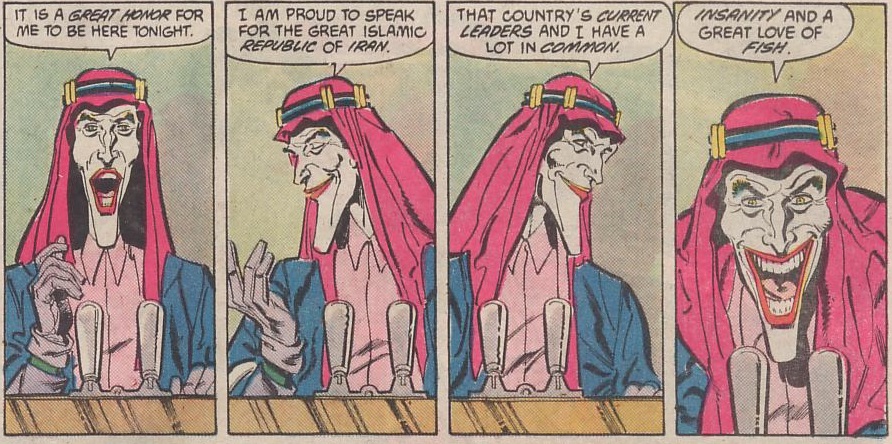 Batman #429
Batman #429
More generally, ‘A Death in the Family’ was the culmination not only of Jim Starlin’s so-gritty-it-hurts run, but of a broader dark cycle that included the likes of Batman: Year One, The Killing Joke, and Arkham Asylum… and I think one of the consequences of hitting rock bottom was that the Bat-books bounced back by mostly moving away from such an extremely bleak mood for a while.
The nineties have a reputation as a time when Batman comics lost their sense of fun, but it was actually in the late 1980s and early 2000s that things got really depressing (both times culminating in the deaths of a Robin). As far as I’m concerned, even though the Caped Crusader himself became quite serious, the ‘90s produced tons of fun adventures set in Gotham City, many of which featured a well-adjusted Robin (Tim Drake). Even Bruce Wayne’s temporary replacement with a madman in Knightfall was more critique than celebration of the notion of a dickish, über-violent Dark Knight…
Finally, for better or worse, Jason Todd’s death became a defining moment in Batman’s history. It was Bruce’s biggest failure and, naturally, it haunted his relationship with the Joker and with subsequent Robins. Writers sparingly tapped into this trauma to bring in a sense of gravitas to their stories. For example, in the crossover Underworld Unleashed, written by Mark Waid, the demon Neron exploited the Caped Crusader’s guilt in order to tempt him into a Faustian bargain.
In 1996, Batman actually visited Hell:
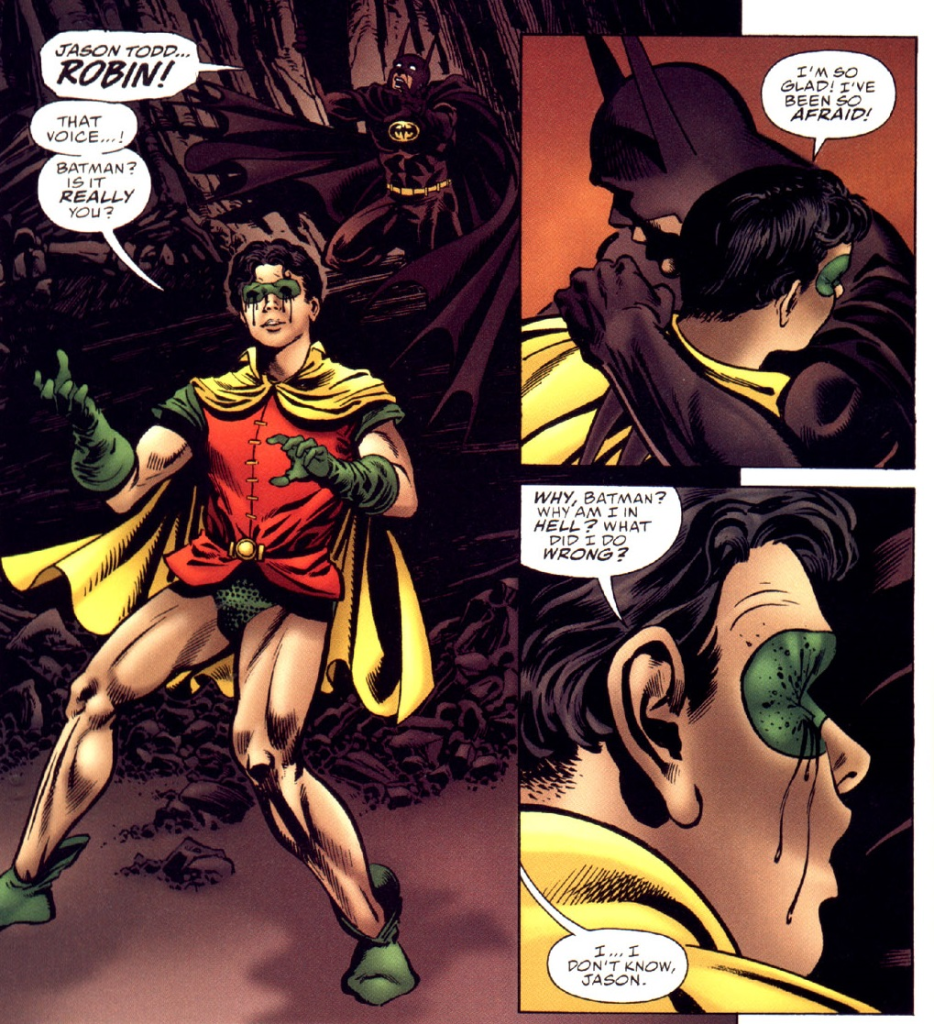 Batman/Demon
Batman/Demon
These nods helped keep Jason’s memory alive. Thus, Robin’s demise remained a powerful and unique moment that resonated throughout the ages.
Well, at least until 2005:



